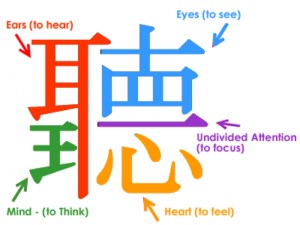A Checklist for Active Listening

As an organization matures on the journey to organizational excellence, leaders shift their role to serve as coaches. In this environment it is important to build coaching capabilities within the Process Improvement team and among front-line managers. In the PI role, coaching for technical competency – like teaching tools is a skill used daily. However, coaching for development, helping to challenge people’s thinking, is a different skill set. Coaching someone for development can be hard, especially if someone is new to coaching or if they are coaching a superior in their organization. In these situations, people often feel like they must have all the answers or put extra pressure on themselves to solve the problems. The fact is, they are the coach, and the learner is often the expert. For the coach, the desired outcome in this scenario is the learning and growth for the learner, not solving the problem. It is important for coaches to get out of their own heads and focus on the learner.
 Active listening is a foundational skill for coaching, especially when coaching for development. I keep an image of the Chinese symbol for listening at my desk to remind me how to actively listen. What I appreciate is that it grounds me in all the aspects of listening, beyond hearing the words, to incorporate information from five different senses. The pause to reflect on my intent to present in these ways helps me focus when I am approaching a coaching situation or conversation and I feel pressure in my desire to be able to help the other person. This is a strategy that takes the pressure off the situation and stops me from getting in my own way, allowing me to focus on the learner.
Active listening is a foundational skill for coaching, especially when coaching for development. I keep an image of the Chinese symbol for listening at my desk to remind me how to actively listen. What I appreciate is that it grounds me in all the aspects of listening, beyond hearing the words, to incorporate information from five different senses. The pause to reflect on my intent to present in these ways helps me focus when I am approaching a coaching situation or conversation and I feel pressure in my desire to be able to help the other person. This is a strategy that takes the pressure off the situation and stops me from getting in my own way, allowing me to focus on the learner.
Let me break down the components to show you how this approach to active listening can be applied in a coaching situation.
Use your Ears to Hear
For active listening you need to use your ears to hear (I know, this is pretty obvious, right?). You need to not only hear what the learner is saying, but how they are saying it. Words matter. Tone and the pattern of providing information matter as well and provide good insight about how the learner is thinking and feeling.
Use your Eyes to See
Active listening also requires you to use your eyes to see. This could mean seeing body language or other non-verbal cues that might give you more understanding into what the other person is thinking or feeling about the situation or problem. Your eyes might also be used to observe the learner in the gemba to learn more about the situation. You may even be seeing data or visuals that illustrate the current situation.
Use your Heart to Feel
Active listening involves having some compassion for the person you are coaching; this is using your heart to feel. Compassion can go a long way in a coaching relationship and in a coaching conversation. Using the information you are gathering with your other senses will help you gain an understanding of the other person and start to feel where they are coming from.
Use your Mind to Think
When you are truly actively listening, you need to engage your mind as well. Think about the information you are receiving from all your senses and put it together. What questions do you have to pose to the person you are coaching?
Give your Undivided Attention to Focus
Finally, you should be giving the other person your undivided attention. Free yourself of distractions and really focus on them. This will enable you to bring all the components of active listening together and demonstrates respect for the person you are listening to. Sometimes this is referred to as coaching presence. According to Carly Anderson and Karen Boskemper, PPC, in their article Unconscious Bias in Coaching, coaching presence means being present and curious about who the learner is and what they are saying.
Active listening is a valuable method when learning to coach and when coaching someone higher up in the organization. Focusing on active listening is one practice I use to get out of my own way and really focus on the person I am coaching. It also allows me to act in service to the other person because it helps to truly understand their thinking. A coach of mine, Margie Hagene, always says, “Until I knew what you were thinking, I did not know which question you needed me to ask.” When I focus on all five elements of active listening, I am better able to ask questions to support their development.
I would love to hear any tips or strategies you have used to practice active listening. Please share in the comments section below.
Related Items
Building Coaching Capabilities workshop
How to Lead by Asking Effective Questions workshop
Catalysis Healthcare Value Network
Catalysis Academy Organizational Subscriptions








Leave a Reply to Brian Armbrust Cancel reply